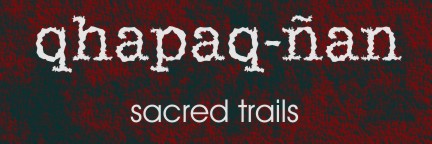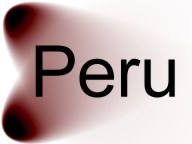


NOTE: The trip
is very flexible and can easily be modified to accommodate specific
group interests or goals. Feel free to ask us for suggestions!
Day 1:
We will pick you up at the airport in Cuzco, on the evening of the 2nd, or morning of the 3rd (03 May 2004). You will spend the first day relaxing in capital of the Inca Empire. Deppending on how you feel we can do a tour of the city in the afternoon. We will have wine and crackers at the ruins of Sacsayhuaman.
Day 2:
In the morning we will rest and have breakfast. Around noon a local guide will take you out to the ruins Tambomachay, PucaPucara, the caves of Zona X, Temple of the Moon, and Quenqo. We will take evening bus to Quillabamba. Although the trip is a little uncomfortable it is quite critical to our acclimatization.
Day 3:
We arrive in Quillabamba in the early hours of the morning. If there is time we will try to get some more sleep at a hostel before we depart for Huancacalle. We arrive at our trailhead just after noon. After a lunch and siesta we will walk up to watch the sun set over each of the three ruins, Nusta Espana, Rosapata, and Vitcos.
Day 4:
After breakfast we start the hike up a long glacier carved valley. We will bed down in the pampas past the two houses that are known as the town of Ccolpa. Camp at 4050m offers great views of the old Inca trail. (4 hours of walking)
Day 5:
Our morning begins with a two-hour climb over Abra Choquetecarpo, a 4610m (15,100 feet) pass. From the pass we descend down the ancient Inca highway to valley of Quelqa. Condors are commonly soaring among the mystical granite towers that loom above this camp. (5 hours of walking)
Day 6:
In the morning we will drop down into the cloud forests. Our path slowly climbs out of the trees as we traverse into the Yanama Valley. We will camp just 15 minutes past a small local village of 300 inhabitants. The views down into the Apurimac gorge are stunning (5 hours of walking)
Day 7:
This is a short but very impressive day. Leaving camp we will hike up the deep valley of Yanama. This valley is the largest producer of potatoes in the region. Turning the corner out of the Yanama valley we will have a short climb to camp in the pampas called Pucara, or the lookout. As the clouds fade in the evening the mountain giants of Pumasillo and Corihuayrachina will make their presence known. The mountains with their gnarled snow ridges stand like sentinels all guarding the passes into the surrounding rivers. (2.5 hours of walking)
Day 8:
We will get an early morning start, which will deliver us to the Puerta Yanama. This, the highest pass on the trek, at 4630m, offers one of the best sunrises in the entire Vilcabamba Range. After a 3 hour descent to the village of Totora we will spend the day with the our wranglers’ families drinking freshly roasted coffee, eating potatoes and celebrating a pachamanka, a traditional meal of meat and potatoes. (4.5 hours of walking)
Day 9:
We will leave all our new friends early in the morning to beat the mid-day heat. This shorter day leaves us in the deep canyon at the junction of two roaring rivers. We will spend the entire afternoon soaking in the incredible hot springs that are a stones’ toss from camp. Parrots and other exotic birds are the only sounds heard above the rivers. (3.5 hours of walking)
Day 10:
Again we will start early to avoid midday heat. As we descend to Playa, the climate becomes more tropical and butterflies and flowers become more abundant. After a short break in Cochapampa, the last town on the road, we will catch a fruit truck with all the locals. The hour-long ride leaves us in the new town of Santa Teresa. (4 hours of walking)
Day 11:
After a breakfast of fresh fruit we will start of the Sacred Valley. The cable traverses make this four-hour walk up the Vilcanota River quite exciting. In the afternoon an hour long train ride will leave us in the touristy town of Aguas Calientes. We can spend a few more hours at hot springs or just have a nice meal at a restaurant and a hot shower.
Day 12:
We will take the 6:30 bus up to check out the ruins of Machu Pichu as the sun rises or for those with a little energy left, we can walk up earlier. You will do a tour with a local and knowledgeable guide and possibly hike up to Huayna Picchu. We will meet back in Aguas Calientes at 2:00pm to have a lunch before the long train ride back to Cuzco.
Day 13:
We will rest for the day in Cuzco. This is a chance to buy some gifts and check out the nightlife in the city.
Day 14:
A six-hour van ride will take us from the highlands of the Andes to the foothills over six hours. For the more adventurous, we can make this descent on mountain bikes. The environment changes from grasslands to tropical rainforest as we descend 3000 meters into the Amazon Basin. Along the way we will stop several times to watch birds and animals. Over 900 species of birds can be found per square kilometer in this area. Camp is on platforms under the canopy.
Day 15:
A two-hour boat ride will take us to the trailhead of a 3-hour foot tour through the true rainforest. Two more hours on boat leave us in Boca Manu.
Day 16:
During the 5 hours we will spend on the boat we will pass an island called Monkey Island. It is home to 9 of the 13 types of monkeys found in Manu. As a change from the tents we will stay at a nice lodge located on the side of the Madre de Dios River.
Day 17:
We will get another early morning start so we can see some nocturnal life. The highlight of the day, however, is a. cliff dropping out of the jungle and into the river. This wall attracts over 40 types of parrots including several species of Macaws. A small plane will take us back from the airport in Manu to Cuzco in the evening.
Day 18:
A Safety Day. Because of the small groups this trip
is extremely flexible and can change a little according to the likes
and dislikes of the individual guests. Because of a “Safety Day”
it would be possible to spend an extra day at the hot springs or in
Machu Pichu according to the wishes of the individuals.
On the other hand in South America there is a high percent of unpredictability.
A “Safety Day” would give us an extra day should something
take longer than expected.